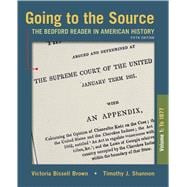Many document readers offer lots of sources, but only Going to the Source combines a rich selection of primary sources with in-depth instructions for how to use each type of source. Mirroring the chronology of the U.S. history survey, each chapter familiarizes students with a single type of source while focusing on an intriguing historical episode such as the Cherokee Removal or the 1894 Pullman Strike. Students practice working with a diverse range of source types including photographs, diaries, oral histories, speeches, advertisements, political cartoons, and more. A capstone chapter in each volume prompts students to synthesize information on a single topic from a variety of source types. The wide range of topics and sources across 28 chapters provides students with all they need to become fully engaged with America’s history.








